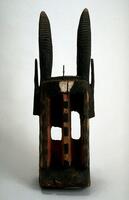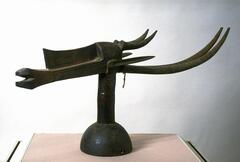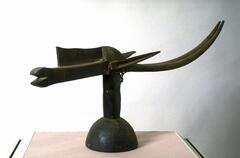9 UMMA Objects
9 UMMA Objects

Dogon (Dogon (culture or style))
Walu Antelope Mask
1900 – 1971
Museum Purchase assisted by the Friends of the Museum of Art
1971/2.26
![Two distinct registers divide a page in half. At the top, a yellow-orange colored nude jina sits in lotus position upon a three tiered throne [a patterned blue level at the bottom on feet, with an orange section with gold and red decoration and a green level at the top with gold vertical stripes]. He sits against a red background adorned with a pattern of three white dots. The background takes the shape of an elegant cusped arch with a green and white pattern along its outside with a gold pattern at its sides. To the right of the seated figure a nude Digambara monk sits with his legs folded and one knee up on a less elaborate throne with a lota or pot at the corner and a crossed bookstand to the side holding a book with some devanagari writing on it. He raises his right arm and holds his left to his ear.<br />
Placed under a band of curving yellow stripes, the bottom register represents animals in a landscape. At the bottom are clumps of grass with four stylized mountain forms in blue at the right. Above the Two distinct registers divide a page in half. At the top, a yellow-orange colored nude jina sits in lotus position upon a three tiered throne [a patterned blue level at the bottom on feet, with an orange section with gold and red decoration and a green level at the top with gold vertical stripes]. He sits against a red background adorned with a pattern of three white dots. The background takes the shape of an elegant cusped arch with a green and white pattern along its outside with a gold pattern at its sides. To the right of the seated figure a nude Digambara monk sits with his legs folded and one knee up on a less elaborate throne with a lota or pot at the corner and a crossed bookstand to the side holding a book with some devanagari writing on it. He raises his right arm and holds his left to his ear.<br />
Placed under a band of curving yellow stripes, the bottom register represents animals in a landscape. At the bottom are clumps of grass with four stylized mountain forms in blue at the right. Above the](/media/W1siZiIsIjIwMjIvMDUvMjUvMXoxZ2ZnNHN6Zl9kZWZhdWx0LmpwZyJdLFsicCIsInRodW1iIiwiMjQweDIwMCJdXQ?sha=54d3764ea6247e3b)
Artist Unknown, India, Rajasthan, Sirohi School
Jain Tirthankara and a monk with animal forest scene, no. 12 from a Digambara series
18th century
Gift of Dr. and Mrs. Leo S. Figiel and Dr. and Mrs. Steven J. Figiel
1975/2.178

Bamana (Bamana)
Chi Wara Headdress
1900 – 1971
Museum Purchase assisted by the Friends of the Museum of Art
1971/2.18A

Bamana (Bamana)
Antelope (Chi Wara) Headpiece: Female
1900 – 1971
Museum Purchase assisted by the Friends of the Museum of Art
1971/2.18B

Bamana (Bamana)
Female Antelope Headdress (Chi-Wara)
1945 – 1955
Gift of Allen Roberts in memory of Sidney H. Roberts
1985/1.137

Dogon (Dogon (culture or style))
Antelope Mask
1900 – 1970
Museum Purchase assisted by the Friends of the Museum of Art
1971/2.29
Loading…


